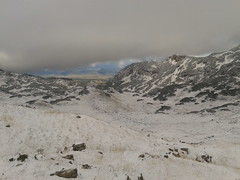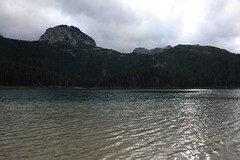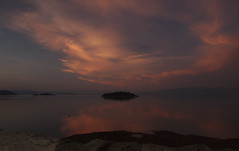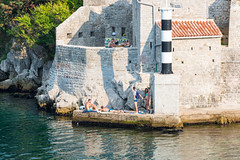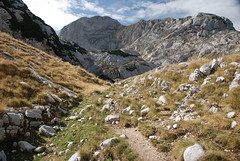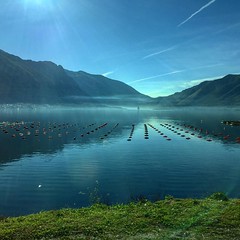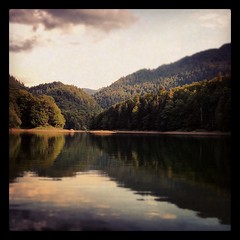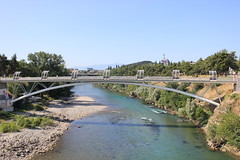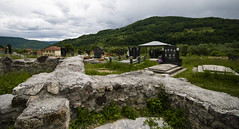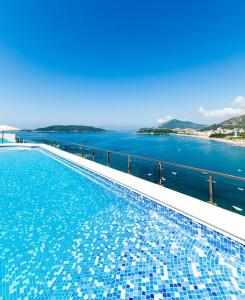 Montenegro
Montenegro
Montenegro (English: /ˌmɒntᵻˈnɡr-ˈnɡr-ˈnɛɡr/;) is a country in Southeastern Europe. It is a part of the Balkans and is bordered by Bosnia and Herzegovina to the north, Serbia to the northeast, Kosovo to the east, Albania to the southeast, Croatia to the northwest, and the Adriatic Sea to the west with a coastline of 293.5 km. Podgorica, the capital and largest city, covers 10.4% of Montenegro's territory of , and is home to roughly 31% of its total population of 621,000. Cetinje is the former royal capital of Montenegro and is the location of several national institutions, including the official residence of the president of Montenegro.
During the Early Medieval period, three principalities were located on the territory of modern-day Montenegro: Duklja, roughly corresponding to the southern half; Travunia, the west; and Rascia proper, the north. The Principality of Zeta emerged in the 14th and 15th centuries. From the late 14th century to the late 18th century, large parts of southern Montenegro were ruled by the Venetian Republic and incorporated into Venetian Albania. The name Montenegro was first used to refer to the country in the late 15th century. After falling under Ottoman Empire rule, Montenegro gained its semi-autonomy in 1696 under the rule of the House of Petrović-Njegoš, first as a theocracy and later as a secular principality. Montenegro's independence was recognised by the Great Powers at the Congress of Berlin in 1878. In 1910, the country became a kingdom.
After World War I, the kingdom became part of Yugoslavia. Following the breakup of Yugoslavia, the republics of Serbia and Montenegro together proclaimed a federation. Following an independence referendum held in May 2006, Montenegro declared its independence in June 2006 and the confederation dissolved.
Montenegro has an upper-middle-income economy and ranks 48th in the Human Development Index. It is a member of the United Nations, NATO, the World Trade Organization, the Organization for Security and Co-operation in Europe, the Council of Europe, and the Central European Free Trade Agreement. Montenegro is also a founding member of the Union for the Mediterranean, and is currently in the process of joining the European Union.
Etymology
The country's English name derives from Venetian and translates as "Black Mountain", deriving from the appearance of Mount Lovćen when covered in dense evergreen forests.
The native name Crna Gora, also meaning "black mountain" or "black hill", was mentioned for the first time in a charter issued by Stefan Milutin. It came to denote the majority of contemporary Montenegro in the 15th century.
Modern-day Montenegro was more and more known by that name in the historical period following the fall of the Serbian Despotate. Originally, it had referred to only a small strip of land under the rule of the Paštrovići tribe, but the name eventually came to be used for the wider mountainous region after the Crnojević noble family took power in Upper Zeta. The aforementioned region became known as Stara Crna Gora 'Old Montenegro' by the 19th century to distinguish the independent region from the neighbouring Ottoman-occupied Montenegrin territory of Brda '(The) Highlands'. Montenegro further increased its size several times by the 20th century, as the result of wars against the Ottoman Empire, which saw the annexation of Old Herzegovina and parts of Metohija and southern Raška. Its borders have changed little since then, losing Metohija and gaining the Bay of Kotor.
After the second session of the AVNOJ during World War II in Yugoslavia, the contemporary modern state of Montenegro was founded as the Federal State of Montenegro (Montenegrin: Савезна држава Црне Горе / Savezna država Crne Gore) on 15 November 1943 within the Yugoslav Federation by the ZAVNOCGB. After the war, Montenegro became a republic under its name, the People's Republic of Montenegro (Montenegrin: Народна Република Црна Гора / Narodna Republika Crna Gora) on 29 November 1945. In 1963, it was renamed to the Socialist Republic of Montenegro (Montenegrin: Социјалистичка Република Црна Гора / Socijalistička Republika Crna Gora). As the breakup of Yugoslavia occurred, the SRCG was renamed to the Republic of Montenegro (Montenegrin: Република Црна Гора / Republika Crna Gora) on 27 April 1992 within the Federal Republic of Yugoslavia by removing the adjective "socialist" from the republic's title. Since 22 October 2007, a year after its independence, the name of the country became simply known as Montenegro.
History
Antiquity
Modern-day Montenegro was part of Illyria and populated by the Indo-European-speaking Illyrians. The Illyrian kingdom was conquered by the Roman Republic in the Illyro-Roman Wars and the region was incorporated into the province of Illyricum (later Dalmatia and Praevalitana).
Arrival of the Slavs
Three principalities were located on the territory: Duklja, roughly corresponding to the southern half, Travunia, the west, and Raška, the north. Duklja gained its independence from the Byzantine Roman Empire in 1042. Over the next few decades, it expanded its territory to neighbouring Rascia and Bosnia, and also became recognised as a kingdom. Its power started declining at the beginning of the 12th century. After King Bodin's death (in 1101 or 1108), civil wars ensued. Duklja reached its zenith under Vojislav's son, Mihailo (1046–1081), and his grandson Constantine Bodin (1081–1101).
As the nobility fought for the throne, the kingdom was weakened, and by 1186, the territory of modern-day Montenegro became part of the state ruled by Stefan Nemanja and was a part of various state formations ruled by the Nemanjić dynasty for the next two centuries. After the Serbian Empire collapsed in the second half of the 14th century, the most powerful Zetan family, the Balšićs, became sovereigns of Zeta.
By the 13th century, Zeta had replaced Duklja when referring to the realm. In the late 14th century, southern Montenegro (Zeta) came under the rule of the Balšić noble family, then the Crnojević noble family, and by the 15th century, Zeta was more often referred to as Crna Gora.
In 1421, Zeta was annexed to the Serbian Despotate, but after 1455, another noble family from Zeta, the Crnojevićs, became sovereign rulers of the country, making it the last free monarchy of the Balkans before it fell to the Ottomans in 1496, and got annexed to the sanjak of Shkodër. For a short time, Montenegro existed as a separate autonomous sanjak in 1514–1528 (Sanjak of Montenegro). Also, Old Herzegovina region was part of Sanjak of Herzegovina.
Early modern period
From 1392, numerous parts of the territory were controlled by Republic of Venice, including the city of Budva, in that time known as "Budua". The Venetian territory was centred on the Bay of Kotor, and the Republic introduced governors who meddled in Montenegrin politics. Venice controlled territories in present-day Montenegro until its fall in 1797. Large portions fell under the control of the Ottoman Empire from 1496 to 1878. In the 16th century, Montenegro developed a unique form of autonomy within the Ottoman Empire that permitted Montenegrin clans freedom from certain restrictions. Nevertheless, the Montenegrins were disgruntled with Ottoman rule, and in the 17th century, repeatedly rebelled, which culminated in the defeat of the Ottomans in the Great Turkish War at the end of that century.
Montenegrin territories were controlled by warlike clans. Most clans had a chieftain (knez), who was not permitted to assume the title unless he proved to be as worthy a leader as his predecessor. An assembly of Montenegrin clans (Zbor) was held every year on 12 July in Cetinje, and any adult clansman could take part. In 1515, Montenegro became a theocracy led by the Metropolitanate of Montenegro and the Littoral, which flourished after the Petrović-Njegoš of Cetinje became the prince-bishop (whose title was "Vladika of Montenegro").
People from Montenegro in this historical period were described as Orthodox Serbs.
Principality and Kingdom of Montenegro
In 1858, one of the major Montenegrin victories over the Ottomans occurred at the Battle of Grahovac. Grand Duke Mirko Petrović, elder brother of Knjaz Danilo, led an army of 7,500 and defeated the numerically superior Ottomans with 15,000 troops at Grahovac on 1 May 1858. This forced the Great Powers to officially demarcate the borders between Montenegro and Ottoman Empire, de facto recognizing Montenegro's independence.
In the Battle of Vučji Do Montenegrins inflicted a major defeat on the Ottoman Army under Grand Vizier Ahmed Muhtar Pasha. In the aftermath of the Russian victory against the Ottoman Empire in the Russo-Turkish War of 1877–1878, the major powers restructured the map of the Balkan region. The Ottoman Empire recognised the independence of Montenegro in the Treaty of Berlin in 1878.
The first Montenegrin constitution (also known as the Danilo Code) was proclaimed in 1855. Under Nicholas I (ruled 1860–1918), the principality was enlarged several times in the Montenegro-Turkish Wars and was recognised as independent in 1878. Nicholas I established diplomatic relations with the Ottoman Empire. Minor border skirmishes excepted, diplomacy ushered in about 30 years of peace between the two states until the deposition of Abdul Hamid II in 1909.
The political skills of Abdul Hamid II and Nicholas I played a major role in the mutually amicable relations. Modernization of the state followed, culminating with the draft of a Constitution in 1905. However, political rifts emerged between the reigning People's Party, who supported the process of democratisation and union with Serbia, and those of the True People's Party, who were monarchist.
In 1910, Montenegro became a kingdom, and as a result of the Balkan Wars of 1912–1913, a common border with Serbia was established, with Shkodër being awarded to Albania, though the current capital city of Montenegro, Podgorica, was on the old borde…

